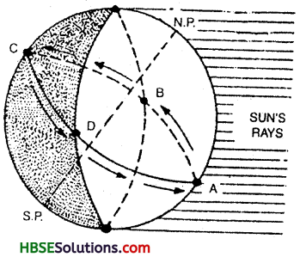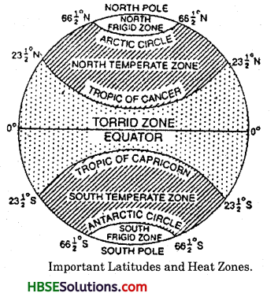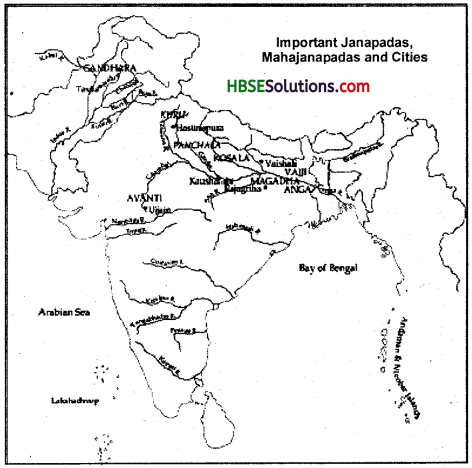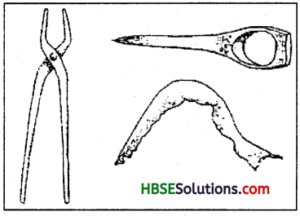HBSE 6th Class Social Science Solutions Civics Chapter 1 Understanding Diversity
Haryana State Board HBSE 6th Class Social Science Solutions Civics Chapter 1 Understanding Diversity Textbook Exercise Questions and Answers.
Haryana Board 6th Class Social Science Solutions History Chapter 1 Understanding Diversity
HBSE 6th Class Civics Understanding Diversity Textbook Questions and Answers
Question 1.
Draw up a list of different festivals celebrated in your locality. Which of these celebrations are shared by members of different regional and religious communities?
Answer:
Festivals celebrated in our locality are:
- Id
- Gurupurab
- Ram Navami
- Christmas
- Holi
- Dussehra
- Diwali
- Buddha Purnima
- Makar Sakranti
- Ramzan
- Lohri
- Baishakhi
- Teej
- Rakshabandhan
- Mahavir Jayanti.
We are all the children of one god. All the religions (Hinduism, Sikhism, Jainism, Buddhism, Islam and Christianity) teach us tolerance, equality and humanity. So the above mentioned festivals are shared by number of people in our community (locality). The festivals including national holidays are celebrated equally by people of different regional and religious communities.
![]()
Question 2.
What do you think living in India with its rich heritage of diversity adds to your life?
Answer:
The people of India belong to different races and castes, and em brace different religions. The inhabitants of the India are greatly different from one another in dress, eating habits and customs. Foreign scholars have termed India as a museum of diverse religions, races, communities and cultures.
This is the only country where unity in diversity and vice-versa breathes comfortably. So we think that living in India with its rich heritage of diversity adds great experience in our life.
Question 3.
Do you think the term ‘Unity in Diversity’ is an appropriate term to describe India? What do you think Nehru is trying to say about Indian unity in the sentence quoted above from his book ‘The Discovery of India’?
Answer:
Yes, this is an appropriate term to describe India. There is diversity in religion, languages, food, clothing, etc. in India. Everybody in India feels proud to call himself. Therself an Indian. They celebrate many festivals together and people of different religions visit each other’s places of worship. They live in the same community and share each other’s joys and sorrows.
They together fought to free India from British rule. Jawaharlal Nehru, the former Prime Minister and the writer of the ‘Discovery of India’ says that the Unity of India is deeper within its fold. The Indians are known for their tolerance, acknowledgment and encouragement for diverse religions and customs.
![]()
Question 4.
Underline the line in the poem sung after Jallianwalla Bagh Massacre, which according to you reflects India’s essential Unity.
Don’t forget the days of blood, O friend In the midst of your happiness remember to shed tear for us
The hunter has torn away every single flower Do plant a flower in the desert garden dear friend
Having fallen to bullets we slept in Jallianwala Bagh
Do light a lamp on this lonely grave O friend The blood of Hindus and Muslims flows together today
Do soak your robe in this river of blood dear friend
Some rot in jails while others lie in their graves
Do shed a few tears for them O friend.
Answer:
It is “The blood of Hindus and Muslims flows together today”.
Question 5.
Choose another region in India and do a similar study of the historical and geographical factors that influences the diversity found there. Are these historical and geographical factors connected to each other? How?
Answer:
We choose ‘Punjab’ region in India and do a similar study of the historical and geopgraphical factors there. Punjab is one of the most fertile plain in India. It is drained five rivers. The climate of Punjab veries from time to time. Like the whole part of the country, it undergoes four climatic changes in a year. In cold season, temperature goes down while in hot season, the temperature becomes very high. This plain is covered on north side by Himalayan ranges.
People of different religions live here. Hinduism, Islam and Sikhism are the religions mostly found here. Punjab produces a huge amount of wheat, rice and sugarcane. From industrial point of view, Punjab is also very rich. Like above mentioned geographical factors, history also influence this region.
From the beginning Punjab has been a number of attack from the foreign invaders, that makes the punjabi people very hard worker and brave. From the earliest time, it remained the very important part of India. All invaders who conquered Punjab were able to conquered India and those who were defeated at frontier state could never see India Punjab is known as the gateway of India. So, we can conclude that both geographical and historical factors are connected with each other. One has deep impact on other and vice-versa.
![]()
HBSE 6th Class Civics Understanding Diversity Important Questions and Answers
Very Short Answer Type Questions
Question 1.
What are communal riots?
Answer:
When arson, looting, fire and killing break out between two communities due to different reasons it is called communal riots.
Question 2.
Name the European sailor who came in search of a sea route to India.
Answer:
The Portuguese discovered the sea route to India, from Europe, when Vasco da Gama landed with his ships here.
Question 3.
Why was Ladakh considered a good trade route?
Answer:
Ladakh was considered a good trade route as it has many passes through which caravans travelled to what is today called Tibet.
Question 4.
By what name is national epic of Tibet known as?
Answer:
Kesar Saga.
![]()
Question 5.
How did the caste system create inequality?
Answer:
In the caste system a person could not change his profession, it was not considered necessary for him to know anything more than what was needed in the profession. This created a situation of inequality.
Short Answer Type Questions
Question 1.
What is inequality ? Give one example of inequality.
Answer:
Inequality comes about when a person does not have the resources and opportunities that are available to other persons. Samir did not have the opportunity to go to school, because his parents are poor and do not have enough to eat and wear.
Question 2.
Why is only very little agriculture possible in Ladakh?
Answer:
Very little agriculture is possible in Ladakh because:
(i) the region does not receive any rain.
(ii) it is covered in snow for large part of the year-1
Question 3.
Who was Ibn Batuta ? What did he write about Kerala?
Answer:
Ibn Batuta was an Arab trader who travelled to Kerala a little less than seven hundred years ago. In a travelogue, he described the lives of Muslims. He wrote that they were a highly respected community.
Question 4.
How did people of India prove that though they had diverse culture, they were united?
Answer:
Indians fought unitedly for the freedom of the country though they were from different backgrounds. They went to jail together. They found different ways to oppose the British.
![]()
Long Answer Type Questions
Question 1.
How do the different cultures affect our lives?
Answer:
We are influenced by the different cultures because:
(a) We move from place to place for work and with each move our lives which are affected by different cultures that exist around us.
(b) In our own neighburhoods we live close to people from several communities.
(c) We hear stories about each other’s lives, customs and traditions and that too has an impact upon our lives.
Question 2.
Describe the Jallianwala Bagh Massacre. How does it reflect unity in diversity?
Answer:
(i) Men and women, Hindus, Sikhs and Muslims, rich and poor had gathered to peaceful protest against the British at Jallianwala Bagh on 13th April 1919.
(ii) A British General Dyer ordered his troops to open fire on a large group of these unarmed, peaceful people.
(iii) Thousands of people were killed. This shows how Indians proved that though they were different in race, culture, religion, languages and tradition; they were all united , they would do anything for India.
![]()
Question 3.
How can we explain diverity?
Answer:
Diversity can be explained in many ways, e.g.,
(i) Two hundred years before people travelled from one part of the world to another, in ships, on horses or camels or on foot. But after the advent of aeroplanes and trains, buses and cars people want to travel by them as journey is comfortable and takes less time.
(ii) Often people went in search of new lands or for trade. Because it took long to reach the destination, people stayed there for a long time. Sometimes people left their homes because of natural calamities, some went in search of work.
(iii) People come from villages to cities to find work. In cities it is often easy to forget how then- lives revolved around the surroundings. In villages they grow their own vegetables and grain. In the cities they depend on the market to buy things.
(iv) Sometimes when people make their homes in new places, they begin to change. Their languages, food, music and religion become a mix of old and new.
(v) Similarly people have to adapt themselves to geographical surroundings, e.g., living near the sea is very different rather living in a mountainous region.
Question 4.
Write how historical and geographical factors have influenced the life of the people in Kerala.
Answer:
Kerala is a state in south-western part of India, near the Arabian sea. It has sea on one side and hills on the other. A number of spices are grown on the hills. Spice trade was a flourishing trade. Pepper, cloves and cardamons were grown. It attracted lots of traders. Jewish and Arab traders were the first to come.
The Apostle of Christ, St. Thomas introduced Christianity to India. The Portuguese discovered the sea route to India. These historical influences led people in Kerala to practise Judaism, Islam and Christianity together with Hinduism. The fertile land and climate are suitable for growing rice and the majority of the people eat rice, fish and vegetables.
The fishing nets are called cheena-vala and utensils used for frying are called cheen-chatti and it is believed that word cheen must have come from China.
![]()
Understanding Diversity Class 6 HBSE Notes
- Diversity: The variety of differences in the traits, looks, behaviour, culture, religion, language, abilities, resources, and opportunities related to different people.
- Habitat: The geographical area in which people live and adapt their lives.
- Resources: Anything that can be of use to the people.
- Unity in Diversity: Oneness among people despite the diversity in traits and emotions.






